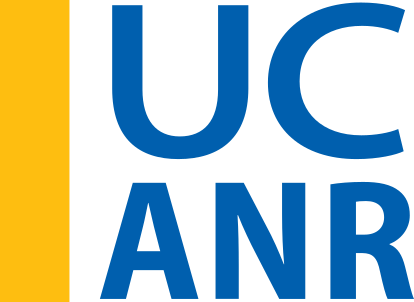- Author: Kathy Keatley Garvey
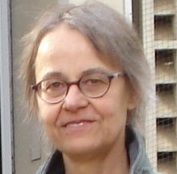
The nine-member research team, led by Frank Schroeder, a BTI professor and also a professor in Cornell University's Department of Chemistry and Chemical Biology, detailed how plants speak “roundworm language” for self-defense. The work is published Jan. 10 in the journal Nature Communications.
The researchers studied chemicals called ascarosides, which the worms produce and secrete to communicate with each other. Williamson helped analyze the data and helped make some key insights toward the paper's conclusions, the BTI scientists related.
The team found that plants “talk” to nematodes by metabolizing ascarosides and secreting the metabolites back into the soil.
“It's not only that the plant can ‘sense' or ‘smell' a nematode,” Schroeder said in a BTI news release. “It's that the plant learns a foreign language, and then broadcasts something in that language to spread propaganda that ‘this is a bad place.' Plants mess with nematodes' communications system to drive them away.”
The study built on the team's previous work showing that plants react to ascr#18 – the predominant ascaroside secreted by plant-infecting nematodes – by bolstering their own immune defenses, thereby protecting them against many types of pests and pathogens.
In those earlier studies, “We also saw that when ascr#18 was given to plants, the chemical disappears over time,” according to lead author Murli Manohar, a senior research associate at BTI.
That observation, along with published literature suggesting plants could modify pest metabolites, led the team to hypothesize that “plants and nematodes interact via small molecule signaling and alter one another's messages,” Schroeder said.
To probe that idea, the team treated three plant species – Arabidopsis, wheat and tomato – with ascr#18 and compared compounds found in treated and untreated plants. They identified three ascr#18 metabolites, the most abundant of which was ascr#9.
The researchers also found Arabidopsis and tomato roots secreted the three metabolites into the soil, and that a mixture of 90% ascr#9 and 10% ascr#18 added to the soil steered nematodes away from the plant's roots, thereby reducing infection.
The team hypothesized that nematodes in the soil perceive the mixture as a signal, sent by plants already infected with nematodes, to “go away” and prevent overpopulation of a single plant. Worms may have evolved to hijack plant metabolism to send this signal. Plants, in turn, may have evolved to tamper with the signal to appear as heavily infected as possible, thereby fooling would-be invaders.
“This is a dimension of their relationship that no one has seen before,” said Manohar. “And plants may have similar types of chemical communication with other pests.”
Although the mixture of ascr#9 and ascr#18 could serve as a crop protectant, Schroeder said there should be no detriment to using straight ascr#18 on crops, as described in the team's earlier research.
“Ascr#18 mainly primes the plant to respond more quickly and strongly to a pathogen, rather than fully inducing the defensive response itself,” he said. “So there should be no cost to the plant in terms of reduced growth, yield or other problems.”
The team also showed that plants metabolize ascr#18 via the peroxisomal β-oxidation pathway, a system conserved across many plant species.
“This paper uncovers an ancient interaction,” Schroeder said. “All nematodes make ascarosides, and plants have had millions of years to learn how to manipulate these molecules.”
He added: “Plants aren't passive green things. They are active participants in an interactive dialog with the surrounding environment, and we will continue to decipher this dialog.”
These discoveries are being commercialized by a BTI and Cornell University-based startup company, Ascribe Bioscience, as a family of crop protection products named PhytalixTM.
Scientists affiliated with four institutions--BTI, Cornell, UC Davis and the USDA's Robert W. Holley Center for Agriculture and Health--co-authored the paper. Grants from USDA and the National Institutes of Health funded the research.
Sources:
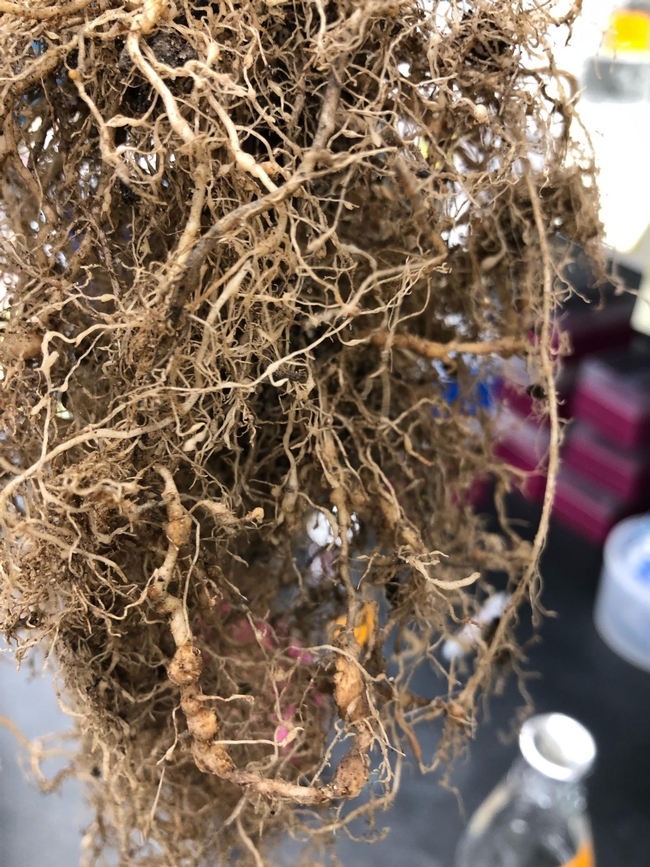
- Author: Kathy Keatley Garvey
An international team of 10 scientists, led by plant nematologist Shahid Siddique, a former research group leader at the University of Bonn, Germany, and now an assistant professor in the UC Davis Department of Entomology and Nematology, has discovered the role of a plant's endodermal barrier system in defending against plant-parasitic nematodes.
“We discovered that the integrity of the endodermis—a specialized cell layer that surrounds the vascular system and helps regulate the flow of water, ions and minerals--is important to restrict nematode infection,” said Siddique, who joined the UC Davis faculty in March after serving several years at the University of Bonn.
“We found that having defects in endodermis make it easier for parasites to reach the vascular cylinder and establish their feeding site. Although, this finding is a result of basic research, it opens new avenues to for breeding resistance against cyst nematodes in crops.”
The research, “Root Endodermal Barrier System Contributes to Defence against Plant‐Parasitic Cyst and Root‐Knot Nematodes,” is published in the July 19th edition of The Plant Journal.
Siddique collaborated with scientists from Germany, Switzerland and Poland: Julia Holbein, Rochus Franke, Lukas Schreiber and Florian M. W. Grundler of the University of Bonn; Peter Marhavy, Satosha Fujita, and Niko Geldner of the University of Lasuanne, Switzrland; and Miroslawa Górecka and Miroslaw Sobeczak of the Warsaw University of Life Sciences, Poland.
“Plant-parasitic nematodes are among the most destructive plant pathogens, causing agricultural losses amounting to $80 billion annually in the United States,” said Siddique. “They invade the roots of almond, tomato, beets, potato or soybeans and migrate through different tissues to reach the central part—the vascular cylinder--of the root where they induce permanent feeding sites.”
“These feeding sites are full of sugars and amino acids and provide the parasite all the nutrients they need,” Siddique explained. “A specialized cell layer called the endodermis surrounds the vascular system and helps regulates the flow of water, ions and minerals into and out of it. However, the role of endodermis in protecting the vascular system against invaders such as nematodes had remained unknown.”
In their abstract, the scientists noted that plant-parasitic nematodes (PPN) “cause tremendous yield losses worldwide in almost all economically important crops. The agriculturally most important PPNs belong to a small group of root‐infecting sedentary endoparasites that includes cyst and root‐knot nematodes. Both cyst and root‐knot nematodes induce specialized long‐term feeding structures in root vasculature from which they obtain their nutrients.”
“A specialized cell layer in roots called the endodermis, which has cell walls reinforced with suberin deposits and a lignin‐based Casparian strip (CS), protects the vascular cylinder against abiotic and biotic threats,” the researchers explained. “Until now, the role of the endodermis, and especially of suberin and the CS, during plant–nematode interactions was largely unknown.”
The team analyzed the role of suberin and CS during interaction between Arabidopsis plants and two sedentary root parasitic nematode species, the cyst nematode Heterodera schachtii and the root‐knot nematode Meloidogyne incognita. “We found that nematode infection damages endodermis leading to the activation of suberin biosynthesis genes at nematode infection sites.”
The research was funded by a grant from the German Research Foundation.

- Author: Kathy Keatley Garvey
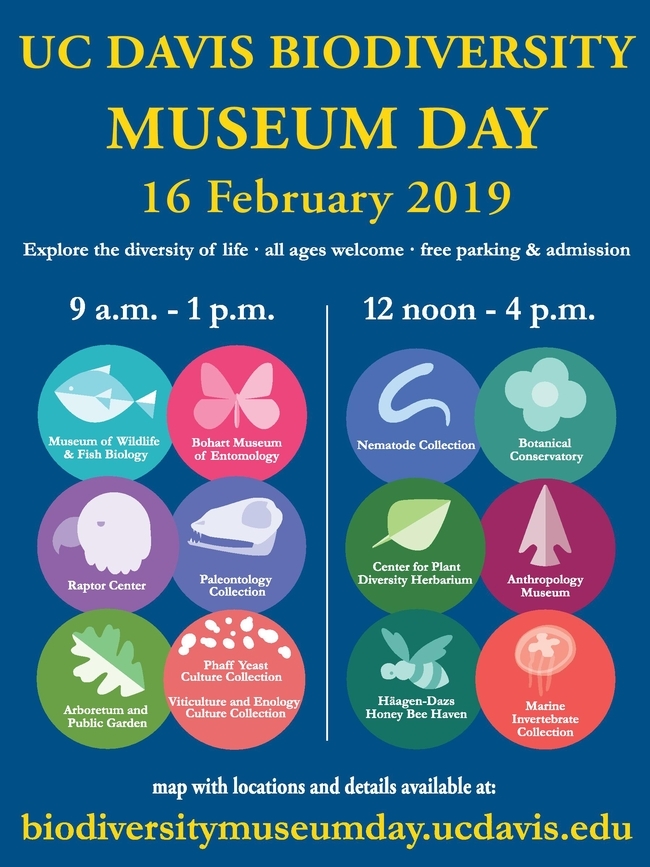
No? Ever watched scientists prepare a bobcat specimen for display? Or taken a selfie with a red-tailed hawk? Or petted a stick insect or a pine cone? How about kombucha tea--ever tasted it?
You can do that and more at the eighth annual UC Davis Biodiversity Museum Day, set from 9 a.m. to 4 p.m., Saturday, Feb. 16. The free, family friendly event will feature 13 museums or collections. All are within walking distance except for the Häagen-Dazs Honey Bee Haven on Bee Biology Road and the Raptor Center on Old Davis Road. The hours vary from 9 a.m. to 1 p.m. and from noon to 4 p.m.
The science-based event, exploring the diversity of life, drew more than 4000 visitors to the campus last year, according to Tabatha Yang, education and outreach coordinator for the Bohart Museum of Entomology.
New this year is the Marine Invertebrate Collection in the Sciences Laboratory Building, off Kleiber Hall Drive. “Visitors can expect to see specimens collected from Oahu and Baja California, and live corals,” said spokesperson Ivani Li. “There will be a touch tank. At some point there will be a brief presentation about squids where we will be showing off our Humboldt Squid or jumbo squid.”
The UC Davis Biodiversity Museum Day, always held the Saturday of Presidents' Day weekend, is billed as a “free, educational event for the community where visitors get to meet and talk with UC Davis scientists from undergraduate students to staff to emeritus professors and see amazing objects and organisms from the world around us.” Parking is also free. Maps are available on the Biodiversity Museum Day website at http://biodiversitymuseumday.ucdavis.edu/.
These seven collections will be open from 9 a.m. to 1 p.m.:
- Arboretum and Public Garden, Good Life Garden, next to the Robert Mondavi Institute, 392 Old Davis Road, on campus
- Bohart Museum of Entomology, Room 1124 of the Academic Surge Building, Crocker Lane
- California Raptor Center, 340 Equine Lane, off Old Davis Road
- Museum of Wildlife and Fish Biology, Room 1394, Academic Surge Building, Crocker Lane
- Paleontology Collection, Earth and Physical Sciences Building, 434 LaRue Road
- Phaff Yeast Culture Collection, Robert Mondavi Institute of Wine and Food Science, 392 Old Davis Road, on campus
- Viticulture and Enology Culture Collection, Robert Mondavi Institute of Wine and Food Science, 392 Old Davis Road, on campus
The following will be open from noon to 4 p.m.:
- Anthropology Museum, 328 Young Hall and grounds
- Botanical Conservatory, Greenhouses along Kleiber Hall Drive
- Center for Plant Diversity, Sciences Laboratory Building, off Kleiber Hall Drive
- Häagen-Dazs Honey Bee Haven, Bee Biology Road, off Hopkins Road (take West Hutchison Drive to Hopkins)
- Nematode Collection, Sciences Laboratory Building, off Kleiber Hall Drive
- Marine Invertebrate Collection, Sciences Laboratory Building, off Kleiber Hall Drive
All participating museums and collections have active education and outreach programs, Yang said, but the collections are not always accessible to the public. Maps, signs and guides will be available at all the collections, and also online at http://biodiversitymuseumday.edu, and on social media, including Facebook and Twitter, @BioDivDay.
Capsule information on each:
Arboretum and Public Garden
The Arboretum and Public Garden will present “investigation stations” from 9 a.m. to 1 p.m. at the Good Life Garden, next to the Robert Mondavi Institute, 392 Old Davis Road, on campus. Visitors will learn about the importance of bees, hummingbirds and moths as pollinators. They can play fun games, and color and craft their own pollinator pets.
Bohart Museum of Entomology
The Bohart Museum of Entomology, located in Room 1124 of the Academic Surge Building on Crocker Lane, will be open from 9 a.m. to noon, The Bohart is the home of a world-class collection of nearly 8 million insect specimens. Insect scientists will meet with the public to help them explore insects and spiders (arachnids). Highlights will include the 500,000-specimen butterfly/moth collection, curated by entomologist Jeff Smith. The Bohart maintains a live “petting zoo,” comprised of Madagascar hissing cockroaches, walking sticks and tarantulas.
California Raptor Center
The California Raptor Center, located at 1340 Equine Lane, Davis, just off Old Davis Road, will be open from 9 a.m. to 1 p.m. Visitors will see a living collection of non-releasable raptors, including hawks, owls and a golden eagle. The center's educational ambassador birds will be out "on the fist", so visitors can get a close look and talk to the volunteers about the birds of prey that live in this area.
Museum of Wildlife and Fish Biology
The Museum of Wildlife and Fish Biology, located in Room 1394 of the Academic Surge Building, Crocker Lane (off LaRue Road) will be open from 9 a.m. to 1 p.m. “We're planning an action packed morning with displays highlighting carnivores, bats, reptiles and fish,” said director Andrew Engilis Jr. “There will be specimen preparation demos (bobcat and raptors) as well as a kid crafts table.”
Paleontology Collection
The Paleontology Collection, located in the Earth and Physical Sciences Building, 434 LaRue Road, will be open from 9 a.m. to 1 p.m. Visitors can view fossil specimens dating from as old as 550 million years ago to more recent animal skeletons. Paleontology graduate students in invertebrate and vertebrate paleontology will answer questions and provide interesting factoids.
Phaff Yeast Culture Collection and Viticulture and Enology Culture Collection
These collections will be open from 9 a.m. to 1 p.m. in the Robert Mondavi Institute,392 Old Davis Road, on campus. Visitors can learn about the importance of microbes in research, biotechnology, and food and beverages, and about the proud history of two of the world's prominent microbe collections.
Visitors can
- Tour the UC Davis teaching winery and brewery
- See and smell dozens of yeast species
- Use microscopes to look at yeast cultures
- Learn how yeasts and bacteria are important for making fermented foods and beverages
- Taste vegemite, marmite, and kombucha tea
- Hear how to make clothes from yeast and bacteria
- Hear about cutting edge research using these microbe collections and
- Listen to yeast jokes
Anthropology Museum
The Department of Anthropology Museum, located in 328 Young Hall, will be open from noon to 4 p.m. The Anthropology Museum curates collections of archaeological, ethnographic, biological and archival materials. Visitors will:
- See how different peoples around the world incorporate biodiversity into personal adornment
- Learn about how the native peoples of the Central Valley made use of the area's biodiversity
- Find out what our hominin ancestors looked like
- Explore the anatomical diversity of our primate relatives
- Learn to throw a spear with an atlatl or use a Peruvian sling shot to hit your target
- Learn how to make stone tools by flintknapping
- Explore how archaeologists identify the various animals people used for food, tools, and clothing
The Botanical Conservatory
The greenhouses in the Botanical Conservatory on Kleiber Hall Drive will be open from noon to 4 p.m. Visitors can expect to see carnivorous plants; a chocolate tree loaded with fruit; succulents and other desert plants including the Madagascan spine forest plants that lemurs climb on; the giant leaves of the Titan arum plant, and Mimosa pudica aka sensitive plant whose leaves fold up when touched, said collections manager Ernesto Sandoval. “And, weather permitting, we'll encourage visitors to stroll the paths of the Biological Orchard and Gardens--an outdoor extension of Botanical Conservatory's role in undergraduate education at UC Davis.”
Center for Plant Diversity Herbarium
The Center for Plant Diversity Herbarium, located in Room 1026 of the Sciences Laboratory Building, central campus (off Kleiber Hall Drive), will be open from noon to 4 p.m.. Curator Ellen Dean said visitors can tour the collection area, see plant pressing and mounting demonstrations, “pet our plant zoo” (a table showcasing the diversity of plants, including mosses, pine cones, ferns and flowering plants); look and plants under a microscope, and view oak exhibit. The children's activity? Making herbarium specimens.
Häagen-Dazs Honey Bee Haven
Häagen-Dazs Honey Bee Haven, a half-acre bee demonstration garden located next to the Harry H. Laidlaw Jr. Honey Bee Research Facility, Bee Biology Road, will be open from noon to 4 p.m. "At the Honey Bee Haven, visitors can learn about bees and see the plants they use," said manager Christine Casey. "We'll have tips for identifying bees in gardens, and our catch and release bee vacuums will be available so folks can safely catch and observe bees up close. We'll also be doing an almond tasting event to coincide with the start of California's most economically important crop pollination season." A six-foot long sculpture of a worker bee by artist Donna Billick of Davis anchors the haven, which was planted in the fall of 2009.
Nematode Collection
The nematode collection will open from noon to 4 p.m. in the Science Laboratory Building, (off Kleiber Hall Drive. It will feature both live and slide-mounted nematodes, as well as jars of larger parasites. Nematodes, also called worms, are described as “elongated cylindrical worms parasitic in animals or plants or free-living in soil or water. They exist in almost every known environment.”
Marine Invertebrate Collection
The Marine Invertebrate Collection will open from noon to 4 p.m. in the Science Laboratory Building, off Kleiber Hall Drive. Visitors can view specimens collected from Oahu and Baja California, and live corals. There also will be a touch tank and Humboldt squid presentation.

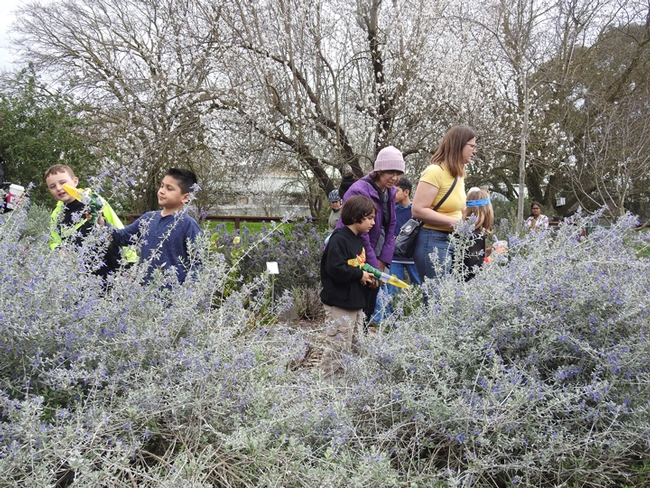
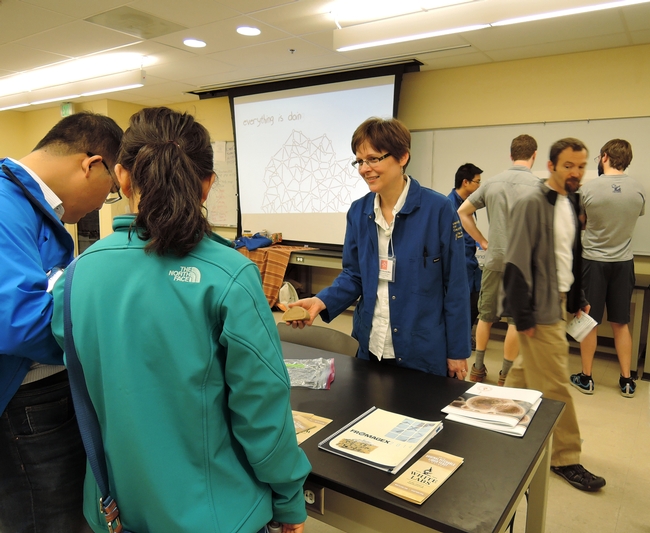

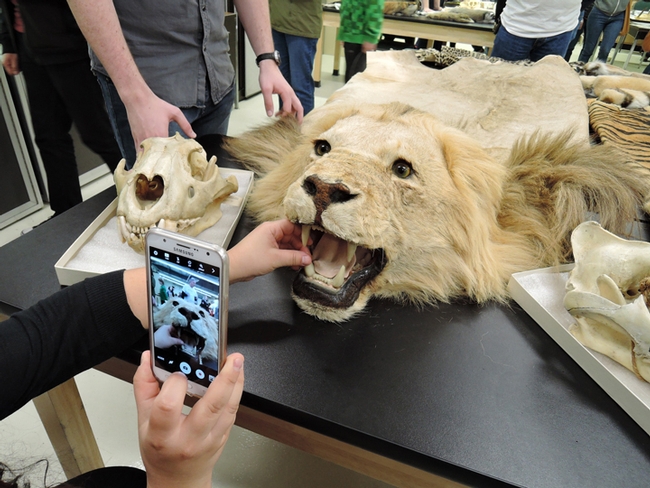
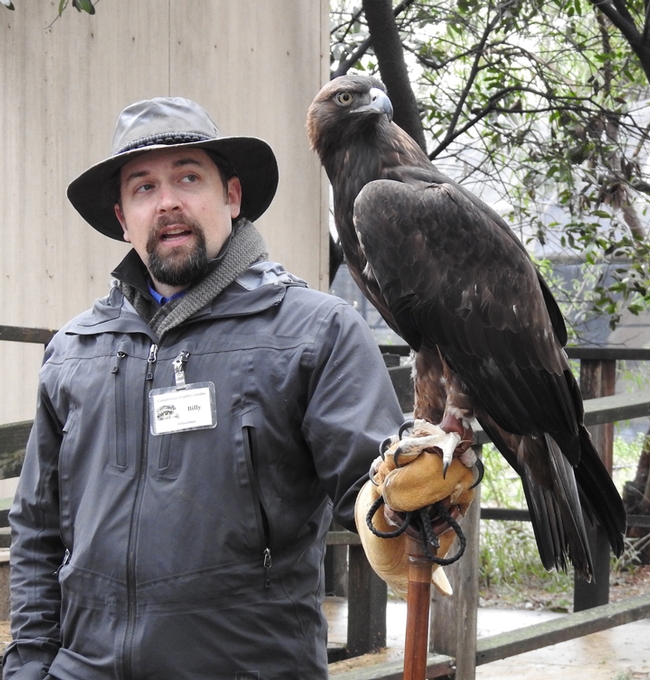

- Author: Kathy Keatley Garvey

His abstract: "His abstract: "Plant infections by root-knot nematodes and the soil-borne fungal pathogen Fusarium oxysporum, which causes vascular wilt, either alone or in disease complexes, result in serious crop losses. Our analyses of host resistance in cowpea and cotton genomes has revealed a rich resource of resistance factors to both pathogens, which are being used in breeding programs for crop improvement."
Of his research, Roberts says: "My research focuses on the integrated management of plant parasitic nematodes. A major emphasis is placed on the identification, characterization, and development of host plant resistance to root-knot nematodes for genetic improvement of crops. Current work includes studies of resistance gene inheritance, development of gene markers, genome mapping, and gene transfer."
He organizes his research on the genetic resistance and associated traits in crop plants to root-knot nematodes in the areas of:
- identifying new sources of resistance genes;
- nature, inheritance and molecular characterization of resistance genes;
- introgressing resistance for breeding line and crop improvement for warm/arid environments using classical and novel techniques;
- assessing and implementing resistant and tolerant lines and cultivars in the field in appropriate cropping systems; and
- studying variability of parasitic specificity within and between nematode species
Host is Steve Nadler, professor and chair of the UC Davis Department of Entomology and Nematology. This is the department's last seminar of the fall quarter.
- Author: Kathy Keatley Garvey
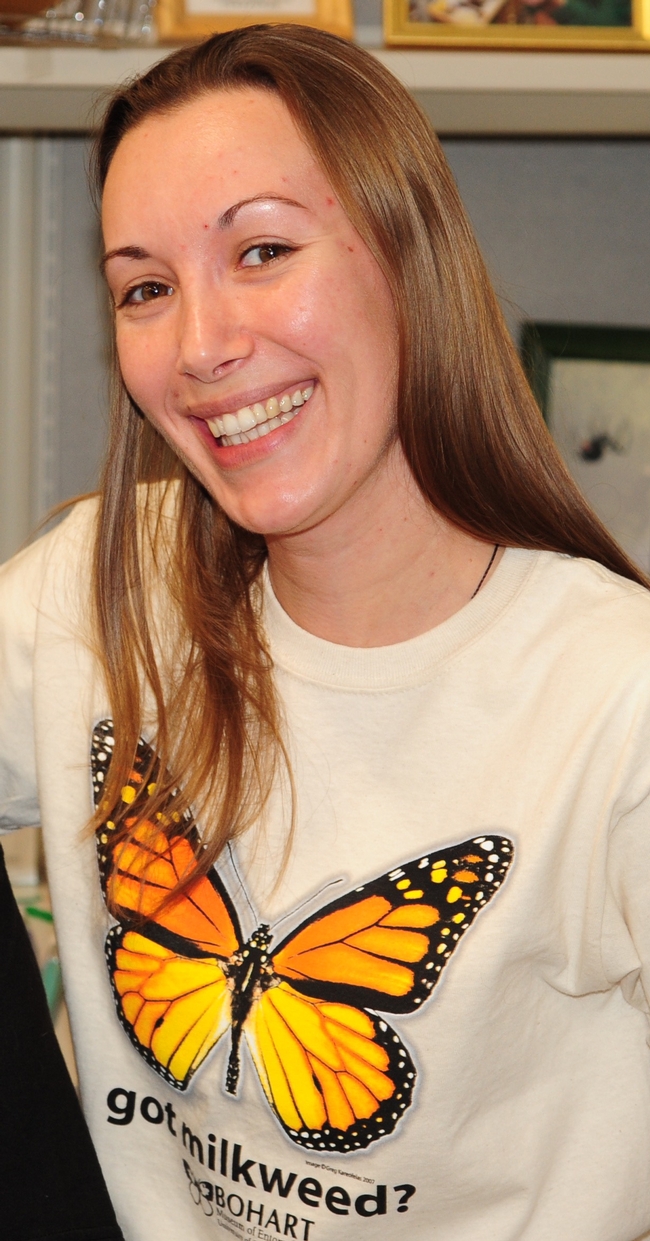
The event, free and open to the public and family friendly, is an annual open house focusing on parasitoids.
"An insect parasitoid is a species whose immatures live off of an insect host, often eating it from the inside out," said Tabatha Yang, education and outreach coordinator of the Bohart Museum. "It is part of their life cycle and the host generally dies."
Among the presentations or topics:
- Bohart Museum senior museum scientist Steve Heydon, a world authority on Pteromalids, or jewel wasps, a group of tiny parasitoids.
- Entomology PhD student Jessica Gillung who researches the Acroceridae family "a remarkable group of endoparasitoids of spiders."
- Diagnostic parasitologist Lauren Camp of the UC Davis Veterinary Medical Teaching Hospital, is an authority on nematodes.
- Family craft activity is a pop-up card, featuring a monarch chrysalis and a fly, suitable for mailing to friends and family during the holiday season.
There are some 3,450 described species of Pteromalids, found throughout the world and in virtually all habitats. Many are important as biological control agents.
Members of the Acroceridae are "rare and elusive flies lay the eggs on the ground or vegetation, and the little larva is in charge of finding itself a suitable host," Gillung said. "Upon finding the host, the larva enters its body and feeds inside until it's mature to come outside and pupate. They eat everything from the spider; nothing is wasted."

Lauren Camp, who received her doctorate from UC Davis, studying with major professor Steve Nadler, professor and chair of the UC Davis Department of Entomology and Nematology, will display a variety of nematodes amd answer questions.
She describes nematodes in one word as "worms" and in expanding, “Nematodes are an amazing phylum of organisms--they exist in almost every known environment on the planet, and different species eat everything from bacteria and fungi to plant and animal tissue."

Tachinid flies, which lay their eggs in caterpillars and chrysalids, will be on display, along with the remains of its hosts. It is used as a biological control agent for some pests. But those who rear monarch butterflies consider it their enemy when it lays eggs in their caterpillars and chrysalids.
The late UC Davis entomologist Richard M. Bohart (1913-2007) researched Strepsiptera, or twisted-wing parasites, for his doctorate in 1938. Both the Bohart Museum and an entire family of Strepsiptera, the Bohartillidae, are named in honor of Professor Bohart.
The Bohart Museum, directed by Lynn Kimsey, professor of entomology at UC Davis, houses a global collection of nearly eight million specimens. It is also the home of the seventh largest insect collection in North America, and the California Insect Survey, a storehouse of the insect biodiversity.
Special attractions include a “live” petting zoo, featuring Madagascar hissing cockroaches, walking sticks, praying mantids and tarantulas. Visitors are invited to hold some of the insects and photograph them. The museum's gift shop, open year around, includes T-shirts, sweatshirts, books, jewelry, posters, insect-collecting equipment and insect-themed candy.
The Bohart Museum holds special open houses throughout the academic year. Its regular hours are from 9 a.m. to noon and 1 to 5 p.m. Mondays through Thursdays. The museum is closed to the public on Fridays, Saturdays and Sundays and on major holidays. Admission is free.
More information on the Bohart Museum is available by contacting (530) 752-0493 or emailing bmuseum@ucdavis.edu or Tabatha Yang at tabyang@ucdavis.edu.

